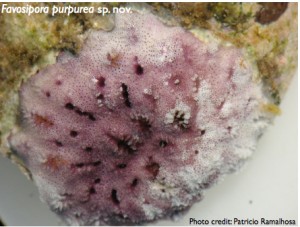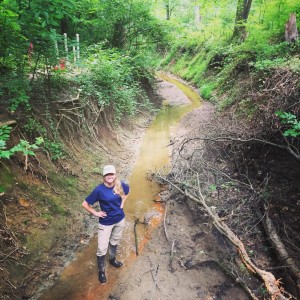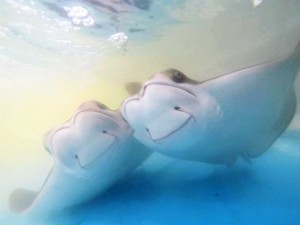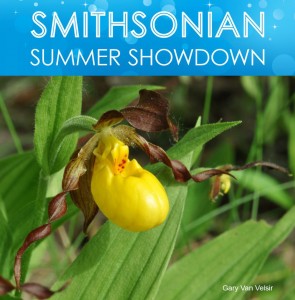by Kristen Minogue
It’s been another wild year at the Smithsonian Environmental Research Center. We sent a sailboat to the Arctic, pitted our orchids in a showdown against the Hope Diamond and discovered a couple new species. And somewhere along the way we celebrated the center’s 50th anniversary. Scroll below for the 2015 #YearInReview, a collection of the top 12 stories, journeys and biggest surprises of 2015.
Exploring the Ocean
Totes Adorbs! Cownose Rays Take Internet
These marine heartthrobs have earned a top billing. Besides making a 900-mile migration every year, which SERC marine ecologists are tracking with acoustic tags, the kite-shaped rays (whose mouths are stretched so that they seem to be wearing a perpetual smile) also won a Twitter #CuteOff in September.
What Does Life in the Ocean Sound Like?
Postdoc Erica Staaterman listens to the ocean for a living. Often seen as a silent landscape broken only by whale or dolphin songs, Staaterman is helping uncover a wealth of noise from the ocean’s hidden creatures. She shared some of the recordings with us in this edited Q&A.
Cruising the Arctic’s Forgotten Fjords
Ocean acidification researcher Whitman Miller sent one of his CO2-monitoring devices on a 100-day journey to the Arctic. Its mission: Venture to some of Greenland’s never-before-seen fjords and discover how melting glaciers are changing the water. And do it all in a small, 42-foot sailboat.
The Social Scene
The Orchid Showdown
Summer was the season for the Smithsonian Showdown, and SERC’s underdog orchids staged a stunning coup when they breezed past the Hope Diamond to make the Round 2 semifinals. Along the way, we got to explore the world of dark Gothic orchids, take lessons from #WhatWouldOrchidDo and uncover some of the crazy and criminal things people have done in the name of orchidelirium. (In case you missed the social media snark, check out the epic Twitter battle of orchids versus the Hope Diamond.)
Beyond #ManicureMonday: Other Ways to Use Nail Polish in Science
We put nail polish on what? Geochemist Hope Jahren’s spinoff of #ManicureMonday inspired scientists across the globe to tweet photos of their fingernails at work. But for field ecologists, manicured hands don’t last very long. So SERC scientists have found other things to decorate with nail polish–all in the name of science.
Fish Don’t Fear Selfie Sticks
Lovers of both the Smithsonian and the selfie stick, rejoice! Though the infamous monopods are banned in Smithsonian museums and galleries, they’ve found a new arena of use: labs.
Species Discoveries
Two New Bryozoan Species Discovered Off Portugal
Since he began surveying the waters of Madeira two years ago, SERC research associate João Canning-Clode has discovered a new invasive species almost every month. The archipelago off the coast of Portugal is a hot spot for biodiversity, especially for bryozoans – “moss animals” that often cover rocks, piers and other artificial substrates. But he didn’t anticipate finding a completely new species, let alone two.
DNA Detects Two Hidden Oysters in Panama
The famous Chesapeake oyster (Crassostrea virginica) has somehow managed to get all the way to Panama. Marine biologists made the surprise discovery during a sampling trip, where they discovered another oyster never seen in the Central American country: the non-native hooded oyster (Saccostrea “cucullata”). There’s a reason both oysters may have escaped notice before. Because oysters look incredibly similar to the naked eye, neither discovery would have been possible without DNA.
Spaghetti Bryozoan Discovered in Galapagos
A new invader has entered Darwin’s stomping ground: The spaghetti bryozoan, Amathia verticillata. Named for its resemblance to clear, gelatinous pasta, it already has a reputation for killing seagrass beds in San Diego and clogging shrimp-fishing gear in Texas. SERC marine biologist Linda McCann discovered the bryozoan while snorkeling in Tortuga Bay, on the south side of Santa Cruz Island.
Seeking Answers in the Danger Zone

SERC Intern Julianne Rolf stands in the streambed of Muddy Creek. Erosion has caused it to drop 10 feet below its floodplain. (SERC)
Resurrecting the Floodplain
States in the Chesapeake have spent hundreds of millions of dollars on stream restoration, but the jury’s still out on what it takes to make them work. So when SERC scientists set out to revive the heavily degraded Muddy Creek in their back woods, they turned the restoration into one massive science project.
Oyster Disease Thrives in Nightly Dead Zones
Low-oxygen dead zones in the deep ocean, which can last anywhere from months to millennia, have created headlines for causing fishkills around the globe. But in the shallows, there are dead zones that appear only at night–and these can be lethal as well, scientists discovered in a paper this February.
Methane Packs More Punch Than We Thought
We’ve been underestimating methane. For years scientists and policymakers have reported that methane is roughly 30 times more powerful than CO2 over a century. This fall, two biogeochemists tested a more accurate model and discovered the true figure is far higher – more like 45 times more powerful than CO2. The good news? Taking methane out of the atmosphere makes an even bigger difference than putting it in.



